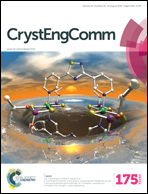Multifunctional mixed ligand metal organic frameworks: X-ray structure, adsorption, luminescence and electrical conductivity with theoretical correlation†
Abstract
Two new mixed ligand metal–organic frameworks of Zn(II) with disodium 5-hydroxyisophthalate and 4,4′-azobispyridine (azbpy) ligands, {[Zn(azbpy)(HO-1,3-bdc)(H2O)]·(azbpy)}n (1) and {[Zn(azbpy)0.5(HO-1,3-bdc)(C2H5OH)]·(H2O)}n (2) have been synthesized by changing the reaction medium (methanol to ethanol) and structurally characterized by elemental analysis, IR, PXRD, TG and single crystal X-ray diffraction. Compound 1 exhibits a 2D sheet network structure with free azbpy ligands in its void space, and is stabilized by π–π and C–H⋯π interactions, whereas 2 has a 2D layered architecture with lattice water molecules in its void space. Compound 2 has a flexible structure and shows gated adsorption (gas and solvent) behavior, while framework 1 is nonporous. These two MOFs exhibit remarkable electrical conductivity values at room temperature and their comparison is discussed carefully. Theoretical calculations suggest that both the compounds are p-type semiconductors and correlate the structure–property relationship. Schottky barrier diode electronic devices have been fabricated by using these two semiconductor materials with aluminium (Al) and indium tin oxide (ITO) in sandwich configuration, ITO/MOF-1 or 2/Al, and both the devices exhibit sound rectification behavior. The photoluminescent properties of both the compounds in the solid state are also investigated in detail.


 Please wait while we load your content...
Please wait while we load your content...